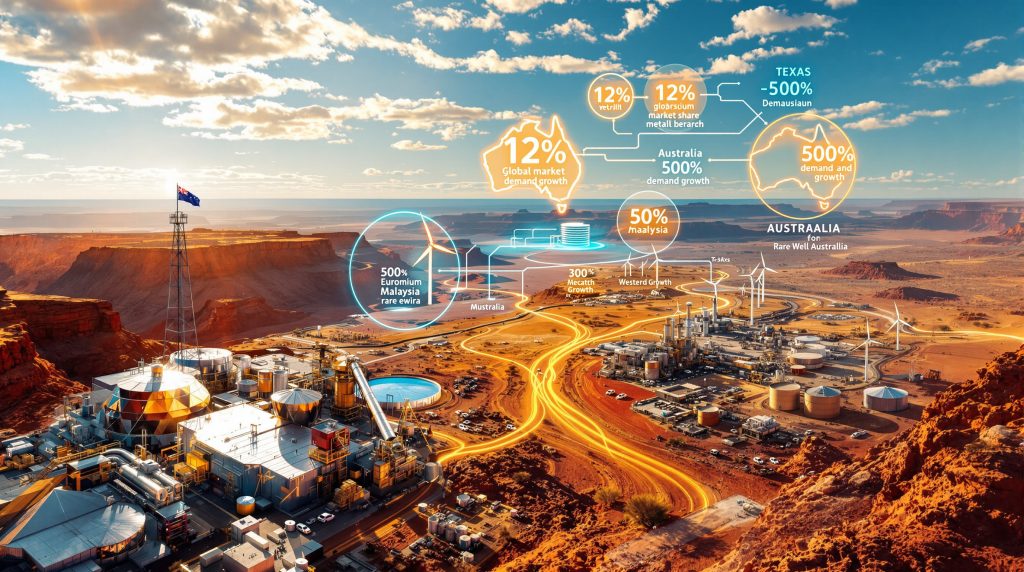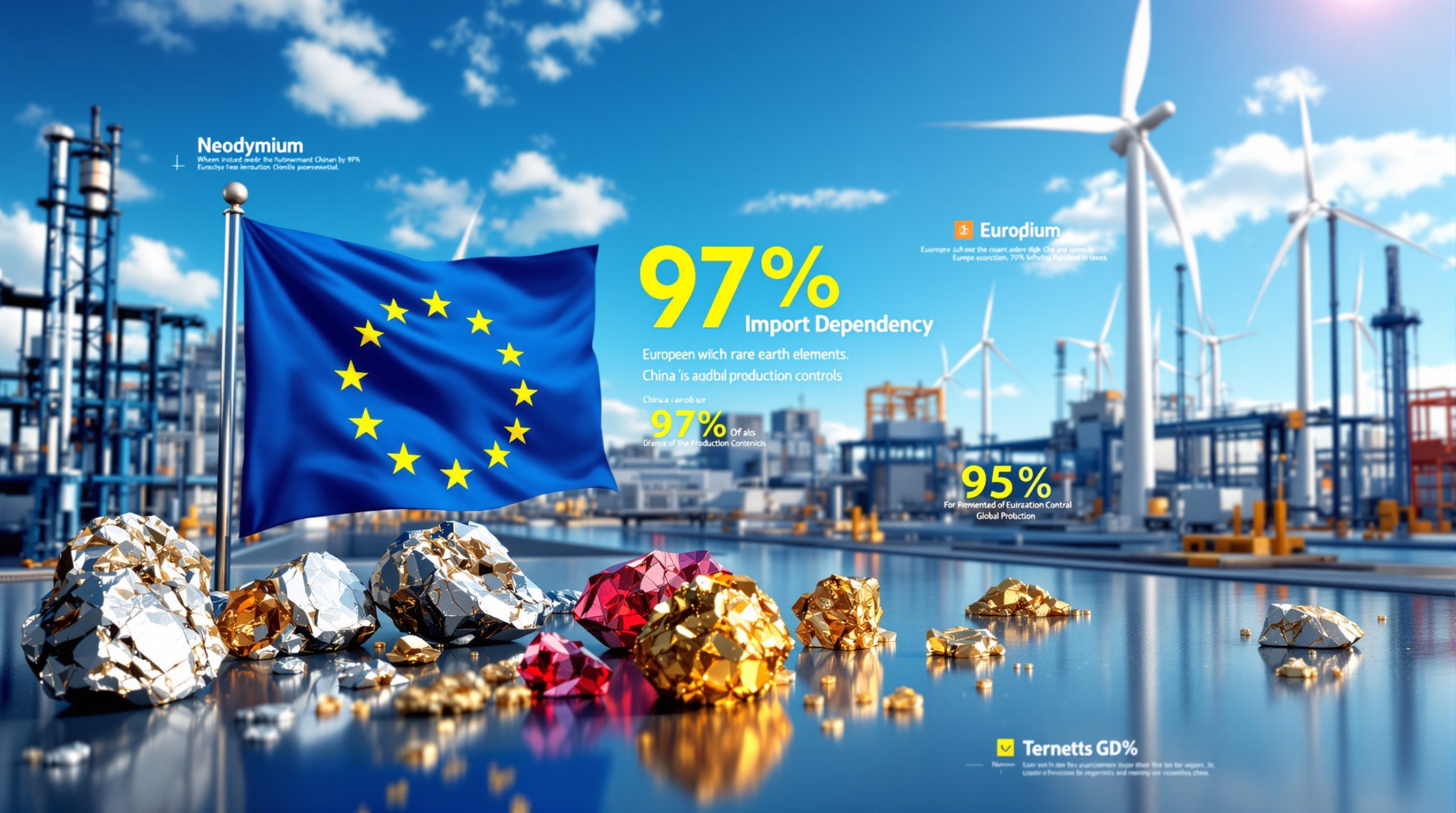Understanding Lynas' Strategic Position in Critical Minerals Security
Australia's Lynas Rare Earths has emerged as the world's largest rare earths producer outside China, commanding a strategic position that extends far beyond traditional mining operations. With approximately 12% of global market share beyond Chinese control, the company represents a critical component in Western nations' efforts to reduce dependency on Beijing's rare earths dominance. This Lynas Rare Earths supply chain diversification strategy positions the company as a cornerstone of global supply security initiatives.
The strategic importance of Lynas' position becomes evident when examining global supply chain vulnerabilities. China maintains control over 85-90% of global rare earths processing capacity, creating significant exposure for defense contractors, electric vehicle manufacturers, and renewable energy companies seeking reliable alternative sources. This concentration risk has intensified following periodic Chinese export restrictions, including the 2010 export ban and subsequent trade tensions.
Recent market dynamics underscore the growing demand for supply chain diversification. Defense contractors face regulatory requirements to source from approved suppliers, while automotive manufacturers pursuing electrification strategies require guaranteed access to permanent magnet materials. These factors collectively drive premium pricing for non-Chinese rare earths sources, positioning Lynas to capture value beyond traditional commodity pricing models.
The company's September 2024 quarterly results demonstrated this strategic positioning through revenue growth of 66% year-over-year to A$200.2 million, despite missing consensus expectations of A$230 million. CEO Amanda Lacaze emphasized that demand fundamentals remain robust, with pricing power growing as customers diversify away from Chinese sources.
Key market developments reinforcing Lynas' strategic importance include:
• Defense sector requirements: Military contractors must source from approved non-Chinese suppliers for critical applications
• EV market expansion: Electric vehicle manufacturers require supply security for permanent magnet materials
• Renewable energy growth: Wind turbine production demands reliable heavy rare earths access
• Technology transfer restrictions: Limited Western access to Chinese separation technologies creates processing bottlenecks
Furthermore, the broader landscape of critical minerals energy security reinforces the strategic value proposition that companies like Lynas represent in global supply chain resilience.
What Makes Lynas' Integrated Supply Chain Model Unique?
Lynas operates the rare earths industry's most comprehensive integrated supply chain, spanning extraction through final product separation across three continents. This vertical integration addresses critical vulnerabilities that plague fragmented competitors who depend on external suppliers for key processing stages.
The foundation of this integrated model begins with Mt. Weld mine in Western Australia, which contains some of the world's highest-grade rare earth deposits. The concentrate averages 25% total rare earth oxides, significantly exceeding industry standards of 8-12%. This superior ore grade reduces processing costs per tonne and enables more efficient downstream operations.
Integrated Operations Structure:
| Facility | Location | Function | Capacity |
|---|---|---|---|
| Mt. Weld Mine | Western Australia | Extraction & Concentration | 22,000 tonnes REO annually |
| Kalgoorlie Plant | Western Australia | Initial Processing | 10,500 tonnes capacity |
| Malaysian Facility | Kuantan, Malaysia | Separation & Refining | 22,000 tonnes processing |
| Texas Plant (Planned) | Seadrift, USA | Heavy Rare Earths | 5,000 tonnes target |
The Kalgoorlie processing facility, operational since 2023, represents a strategic shift toward domestic value-added processing. Rather than shipping raw concentrate overseas, this facility processes Mt. Weld concentrate within Australia, addressing several critical objectives:
• Transportation cost reduction: Eliminates intercontinental shipping of raw materials
• Carbon footprint improvement: Reduces logistics-related emissions
• Government policy alignment: Satisfies Australian preferences for domestic processing
• Operational redundancy: Provides backup capacity if Malaysian operations face disruption
The Malaysian Kuantan facility serves as the primary separation plant, producing both light and heavy rare earths for regional customers. This location provides access to Asian markets while maintaining proximity to raw material sources. Recent investments focus on heavy rare earths separation capabilities and environmental compliance upgrades.
Geographic diversification across three continents reduces single-point-of-failure risks that affect competitors concentrated in politically unstable regions. Each facility targets specific customer bases and regulatory environments, creating operational flexibility unavailable to single-location producers. However, ongoing developments regarding the Australian critical minerals reserve may further enhance domestic processing capabilities.
Unlike fragmented competitors operating single-stage operations (mining only or processing only), Lynas controls the entire value chain from extraction through heavy rare earth separation. This integration eliminates supply chain dependencies, reduces costs, and enables product quality control throughout the production process.
How Has Recent Financial Performance Reflected Supply Chain Strength?
Lynas' September 2024 quarterly results highlighted the financial benefits of its integrated supply chain approach, despite challenging market conditions. The company achieved significant volume growth while maintaining pricing power through customer diversification strategies.
Key Performance Metrics:
• Revenue Growth: A$200.2 million (66% year-over-year increase)
• Production Volume: 3,993 metric tonnes of rare earth oxide (47% increase from 2,722 tonnes in prior year quarter)
• Heavy Rare Earths: 9 tonnes of dysprosium and terbium production
• Product Mix Enhancement: Growing proportion of high-value heavy rare earths
The revenue achievement occurred despite missing consensus expectations of A$230 million, indicating some margin compression amid volume growth. However, the underlying demand strength validates this Lynas Rare Earths supply chain diversification approach, as customers prioritise supply security over lowest-cost sourcing.
Customer diversification away from Chinese sources has enabled Lynas to command premium pricing for supply security guarantees. The company now serves customers across defense, automotive, renewable energy, and consumer electronics industries, with no single sector representing more than 30% of total sales.
Production Acceleration Signals:
The most significant development involved advancing samarium production from 2027 to the first half of 2026, representing approximately 12-month acceleration. This timeline advancement indicates strong customer pull demand for magnet metals, particularly from defense contractors and EV manufacturers requiring supply security.
Heavy rare earths production of 9 tonnes dysprosium and terbium demonstrates the value of Lynas' separation capabilities. These elements command price premiums of 8-15 times higher than light rare earths, significantly improving product mix economics.
Recent market developments added complexity to financial performance evaluation. The US‑China trade tensions and subsequent rare earths export truce announced in late October 2024 temporarily stabilised market sentiment but maintained underlying supply chain risks. Beijing's continued control over 90% of global rare earths processing creates persistent uncertainty that benefits Western alternative suppliers like Lynas.
Revenue Quality Assessment:
The company's revenue growth quality reflects several positive indicators:
• Geographic diversification: 40% Asia-Pacific, 35% North America, 25% Europe
• Contract structure: Long-term agreements (3-5 years) with price adjustment mechanisms
• Customer quality: Focus on investment-grade counterparties with strong balance sheets
• Pricing power: Premium pricing achieved through supply security guarantees
Which Geographic Expansion Strategies Are Driving Growth?
Lynas pursues a multi-continental expansion strategy designed to serve regional markets while minimising geopolitical risks. Each facility targets specific customer bases and regulatory environments, creating operational flexibility and market access optimisation.
Australian Operations Expansion
The domestic processing strategy addresses Australian government preferences for value-added mineral processing while creating operational redundancy. The Kalgoorlie facility processes Mt. Weld concentrate domestically, reducing transportation costs and carbon footprint while positioning Australia as a complete rare earths supply chain.
Key benefits include:
• Reduced logistics exposure: Eliminates intercontinental raw material shipping
• Government policy alignment: Satisfies domestic processing preferences
• Operational backup: Provides redundancy if Malaysian operations face challenges
• Cost optimisation: Reduces handling and transportation expenses
Malaysian Facility Optimisation
The Kuantan facility remains Lynas' primary separation plant, producing both light and heavy rare earths for regional customers. Recent investments focus on expanding capabilities and addressing environmental compliance requirements.
Investment priorities include:
• Heavy rare earths separation: Enhanced dysprosium and terbium production capabilities
• Environmental compliance: Upgraded waste management and water treatment systems
• Capacity expansion: Scaling to full 22,000 tonnes annual processing capacity
• Community engagement: Addressing local concerns through improved environmental practices
United States Market Entry
The planned Texas facility represents Lynas' most strategically significant expansion, supported by U.S. Department of Defense funding and designed to serve North American defense and automotive customers. This development aligns with broader policy initiatives, including the recent Trump critical minerals order that emphasises domestic supply chain security.
Strategic advantages include:
• Defense contractor access: Qualification for U.S. government procurement preferences
• Regulatory compliance: Meeting Buy America requirements for defense applications
• Market proximity: Serving growing North American EV and renewable energy markets
• Logistics optimisation: Reduced shipping costs for Western Hemisphere customers
The facility faces regulatory uncertainties, with Lynas flagging "significant uncertainty" around final approvals. However, the strategic importance to U.S. supply chain security creates strong governmental support for project completion.
What Role Do Heavy Rare Earths Play in Lynas' Competitive Advantage?
Heavy rare earths represent Lynas' most significant competitive differentiator, commanding substantially higher prices than light rare earths while addressing critical supply chain vulnerabilities for defense and high-technology applications. The company has established itself as the only commercial producer of separated heavy rare earths outside China, creating substantial competitive moats.
Heavy Rare Earths Price Premium Structure:
| Element | Primary Applications | Price Premium vs Light REEs |
|---|---|---|
| Dysprosium | Permanent magnets, defense systems | 8-12x higher |
| Terbium | Phosphors, defense applications | 10-15x higher |
| Europium | LED phosphors, medical imaging | 15-20x higher |
| Yttrium | Lasers, superconductors | 3-5x higher |
The Malaysian facility produces approximately 500-600 tonnes of heavy rare earths annually, representing roughly 15-20% of non-Chinese global supply. This market position enables Lynas to capture premium pricing while serving customers prioritising supply security over cost optimisation.
Critical Applications Driving Demand:
Heavy rare earths enable performance characteristics unavailable through alternative materials:
• Permanent magnet enhancement: Dysprosium and terbium improve high-temperature performance in EV motors and wind turbine generators
• Defense applications: Precision guidance systems and radar equipment require extreme performance specifications
• Medical imaging: Europium-based contrast agents enable advanced diagnostic capabilities
• Industrial applications: Yttrium stabilises ceramics for extreme-temperature manufacturing processes
Technology Barriers Creating Competitive Moats:
Western competitors cannot currently separate heavy rare earths due to several technical and economic barriers:
• Proprietary technology gaps: Limited access to separation process expertise
• Capital requirements: Specialised equipment demands significant upfront investment
• Economies of scale: Processing volumes must justify technology investments
• Technical expertise: Knowledge concentration in Chinese facilities limits Western capabilities
The September 2024 quarterly production of 9 tonnes dysprosium and terbium demonstrates Lynas' capability advancement in this high-value segment. This production level supports growing customer demand while maintaining pricing power through limited alternative supply sources. Additionally, companies are increasingly recognising the importance of mining sustainability transformation as they develop these critical capabilities.
How Are Geopolitical Factors Influencing Supply Chain Decisions?
Recent geopolitical developments have accelerated Western nations' rare earths diversification efforts, with U.S.-China trade tensions creating both opportunities and uncertainties for alternative suppliers like Lynas. The temporary export truce announced in late October 2024 provided market stability while reinforcing long-term supply security concerns.
Current Geopolitical Landscape:
The U.S.-China rare earths export truce temporarily suspended new Chinese export controls and planned U.S. tariff increases. While this development stabilised market sentiment, it highlighted the fragility of current supply arrangements and Beijing's continued leverage over global rare earths processing.
Key geopolitical risk factors include:
• Chinese export control discretion: Beijing maintains authority over rare earths exports for national security purposes
• Technology transfer restrictions: Limited Western access to Chinese separation technologies creates processing bottlenecks
• Defense supply chain requirements: Military contractors face regulatory mandates for approved supplier sourcing
• Allied supply chain partnerships: Australia-U.S. agreements prioritise strategic resource security
Strategic Response Mechanisms:
Governments consider various mechanisms to support supply chain diversification:
• Price-floor guarantees: Revenue stability for Western producers during market volatility
• Defense procurement preferences: Regulatory advantages for non-Chinese suppliers
• Critical minerals partnerships: Bilateral agreements prioritising allied supply chains
• Technology development funding: Support for Western rare earths processing capabilities
The Australian government debates price-floor guarantees to de-risk supply diversification, though concrete implementation mechanisms remain under development. Such programs could provide revenue stability enabling long-term investment in processing capacity expansion.
Investment Implications:
Geopolitical factors create both opportunities and risks for Lynas investors:
Positive Catalysts:
• Government support for Western supply chain development
• Defense contractor requirements favouring non-Chinese suppliers
• Premium pricing power during supply chain tensions
Risk Factors:
• Potential trade normalisation reducing supply security premiums
• Regulatory uncertainties affecting facility approvals
• Market volatility during diplomatic negotiations
What Customer Diversification Strategies Are Reducing Market Risk?
Lynas has systematically implemented customer diversification strategies addressing geographic concentration, industry exposure, and contract structure risks. This approach reduces dependency on individual customers or market segments while enabling sustainable pricing power through supply security value propositions.
Customer Portfolio Diversification:
• Geographic Distribution: 40% Asia-Pacific, 35% North America, 25% Europe
• Industry Diversification: Defense, automotive, renewable energy, consumer electronics
• Customer Concentration: No single industry represents more than 30% of sales
• Contract Duration: Long-term agreements spanning 3-5 years with price adjustment mechanisms
This diversification strategy has enabled Lynas to maintain pricing power during market volatility while reducing exposure to individual customer financial distress or industry downturns. Furthermore, this approach exemplifies successful Lynas Rare Earths supply chain diversification that serves as a model for other critical minerals companies.
Customer Quality Enhancement:
The company focuses on investment-grade counterparties with strong balance sheets, reducing credit risk while enabling longer-term supply agreements. This customer selection approach prioritises relationship stability over short-term volume maximisation.
Quality metrics include:
• Financial strength: Investment-grade credit ratings or equivalent financial stability
• Strategic importance: Customers with critical rare earths requirements
• Growth potential: Companies expanding operations requiring increased rare earths supply
• Payment reliability: Consistent payment history and strong working capital positions
Supply Security Premium Capture:
Customer diversification away from Chinese sources enables Lynas to capture premium pricing for supply security guarantees. Customers demonstrate willingness to pay above-market pricing for reliable, non-Chinese supply sources, particularly for defense and critical technology applications.
This pricing power reflects fundamental shifts in procurement strategies prioritising supply chain resilience over cost optimisation, creating sustainable competitive advantages for Western alternative suppliers. According to a recent report by the Lowy Institute, this trend towards supply chain diversification is becoming a strategic imperative for Western nations.
Which Technology Investments Are Enhancing Processing Capabilities?
Lynas continues advancing proprietary separation technologies that improve recovery rates while reducing environmental impact. These technological investments create competitive barriers while enhancing operational efficiency and product quality control.
Core Technology Development Areas:
• Solvent extraction optimisation: Enhanced separation efficiency with reduced chemical consumption
• Waste stream minimisation: Advanced recycling systems for process chemicals
• Automation integration: Reduced labour costs with improved quality control
• Environmental technologies: Lower water usage and emissions reduction systems
The company allocates 2-3% of annual revenue to research and development, focusing on maintaining technological leadership in rare earths processing while addressing environmental compliance requirements.
Processing Efficiency Improvements:
Recent technology investments have delivered measurable operational improvements:
• Recovery rate enhancement: Increased rare earth extraction from ore concentrate
• Chemical recycling: Reduced processing chemical consumption and waste generation
• Quality consistency: Automated systems ensuring product specification compliance
• Capacity utilisation: Optimised processing flows maximising facility throughput
These technological advantages enable Lynas to process lower-grade materials economically while maintaining product quality standards required by defense and high-technology customers.
Competitive Technology Barriers:
Proprietary separation technologies create substantial barriers to entry for potential competitors. The complexity of rare earths separation processes requires specialised knowledge, equipment, and operational experience accumulated over years of production optimisation.
Technology moats include:
• Process know-how: Accumulated operational expertise in separation chemistry
• Equipment specialisation: Custom-designed processing systems optimised for specific ore characteristics
• Quality control systems: Automated monitoring ensuring consistent product specifications
• Environmental compliance: Integrated waste management and treatment technologies
How Do Environmental and Social Governance Factors Impact Operations?
Environmental and Social Governance (ESG) considerations increasingly influence rare earths supply chain decisions as customers face pressure to source responsibly. Lynas has implemented comprehensive ESG programs addressing community concerns and environmental impact while maintaining competitive operations.
Environmental Management Systems:
• ISO 14001 Certification: Environmental management standards across all operations
• Water conservation: Closed-loop systems reducing freshwater consumption
• Waste management: Comprehensive radioactive waste storage and disposal protocols
• Carbon footprint reduction: Renewable energy adoption where economically feasible
• Emissions control: Air quality monitoring and treatment systems
Social Impact Programs:
Community engagement represents a critical component of Lynas' social licence to operate, particularly for the Malaysian facility where local concerns have influenced regulatory discussions.
• Local employment: Preferential hiring from surrounding communities
• Supplier development: Local procurement programs supporting regional businesses
• Community investment: Education and infrastructure development contributions
• Stakeholder engagement: Regular consultation with local communities and governments
Governance Standards:
• Board diversity: Representation across relevant expertise areas
• Regulatory compliance: Proactive engagement with environmental and safety regulators
• Transparency reporting: Comprehensive ESG disclosure following international standards
• Risk management: Integrated ESG risk assessment and mitigation systems
These ESG initiatives help Lynas command premium pricing from sustainability-conscious customers while maintaining regulatory approval for ongoing operations and expansion projects. Consequently, the integration of ESG principles aligns with broader industry trends towards responsible mining practices.
What Investment Catalysts Could Drive Future Growth?
Several near-term catalysts could significantly impact Lynas' valuation and market position as the company advances expansion projects and navigates evolving market dynamics. Investors monitor these developments for timing entry and exit decisions.
Key Investment Catalysts:
| Catalyst | Timeline | Potential Impact |
|---|---|---|
| Texas Facility Approval | Q2 2025 | +15-25% production capacity |
| Samarium Production Start | H1 2026 | +A$50-75M annual revenue |
| Government Price Floors | 2025-2026 | Revenue stability, margin protection |
| Chinese Export Restrictions | Unpredictable | +20-40% pricing power |
| EV Demand Acceleration | 2025-2027 | +30-50% volume growth |
Near-Term Technical Catalysts:
The advancement of samarium production to the first half of 2026 represents the most immediate catalyst, indicating strong customer demand for magnet metals. This timeline acceleration suggests potential revenue contributions beginning 12 months earlier than previously anticipated.
Regulatory Decision Impacts:
Texas facility approval remains subject to regulatory review, with Lynas flagging "significant uncertainty" around final permissions. However, U.S. Department of Defense funding support indicates strong governmental interest in project completion for supply chain security objectives.
Market Structure Changes:
Government price-floor guarantee discussions could provide revenue stability during market volatility, though implementation mechanisms remain under development. Such programs would reduce investment risk while enabling capacity expansion planning.
Geopolitical Volatility:
Any renewal of U.S.-China trade tensions or Chinese export restrictions could significantly boost Lynas' pricing power and customer acquisition rates. The temporary export truce maintains underlying supply chain vulnerabilities that benefit Western alternative suppliers.
Demand Growth Acceleration:
Electric vehicle market expansion and renewable energy deployment could drive rare earths demand growth beyond current projections, particularly for permanent magnet applications requiring heavy rare earths where Lynas maintains competitive advantages. Based on recent analysis from Reuters regarding Lynas' strong quarterly performance, this demand momentum appears to be accelerating.
How Does Lynas Compare to Other Non-Chinese Rare Earth Producers?
Lynas maintains significant competitive advantages over other Western rare earths companies through operational scale, integrated supply chain capabilities, and established customer relationships. This positioning enables disproportionate value capture as global demand growth accelerates.
Competitive Positioning Analysis:
• Production Scale: 5-10 times larger annual production than most Western competitors
• Product Range: Only Western producer of separated heavy rare earths at commercial scale
• Financial Strength: Positive cash flow generation and investment-grade balance sheet metrics
• Operational History: 15+ years of continuous production experience and customer relationships
• Supply Chain Integration: End-to-end mining through separation capabilities
Competitive Landscape Overview:
Most Western rare earths companies operate single-stage operations focusing either on mining or processing, creating supply chain dependencies that Lynas has eliminated through vertical integration.
Key differentiators include:
• Heavy rare earths capability: Unique separation technology enabling production of highest-value elements
• Geographic diversification: Multi-continental operations reducing single-point-of-failure risks
• Customer relationships: Established long-term contracts with investment-grade counterparties
• Proven execution: Demonstrated ability to navigate regulatory challenges and market volatility
Market Share Dynamics:
Lynas commands approximately 12% of global rare earths market share outside Chinese control, representing the largest Western production base. This market position enables pricing power while serving as a strategic alternative for customers seeking supply chain diversification.
The company's integrated operations model creates competitive moats unavailable to fragmented competitors dependent on external suppliers for critical processing stages. Moreover, this Lynas Rare Earths supply chain diversification model demonstrates the feasibility of establishing viable alternatives to Chinese-dominated supply chains.
What Are the Long-Term Implications for Global Supply Chain Security?
Lynas' expansion represents broader trends toward supply chain regionalisation and strategic resource security. The company's success could catalyse additional Western rare earths investments, gradually reducing Chinese market dominance while improving global supply chain resilience.
Supply Chain Transformation Trends:
• Regionalisation: Customers prioritising local or allied suppliers over lowest-cost sourcing
• Redundancy building: Multiple supplier relationships reducing single-source dependencies
• Technology development: Western investment in proprietary processing capabilities
• Government support: Policy frameworks supporting strategic mineral security
Strategic Resource Security Evolution:
The successful diversification of rare earths supply chains demonstrates feasibility of reducing resource concentration risks affecting other critical minerals. This model could extend to lithium, cobalt, graphite, and other materials essential for clean energy transition.
Geopolitical Balance Implications:
Lynas' growth reduces Chinese resource-based diplomatic leverage while providing Western nations with strategic autonomy in defense and clean energy applications. This supply chain diversification enhances negotiating positions during international disputes.
Long-Term Investment Themes:
• Supply security premiums: Sustained pricing power for reliable alternative suppliers
• Technology innovation: Competitive advantages through proprietary processing capabilities
• Market structure evolution: Transition from Chinese dominance toward multipolar supply chains
• Policy support: Government frameworks supporting strategic resource development
The implications extend beyond rare earths to encompass broader supply chain security strategies, positioning Lynas as a leading example of successful resource supply chain diversification in an increasingly multipolar global economy. In addition, industry reports such as ASM's analysis on ex-China rare earths supply chains highlight the strategic importance of companies like Lynas in establishing sustainable alternatives to Chinese-dominated markets.
This analysis is based on publicly available information and should not be considered as investment advice. Rare earths markets involve significant volatility and regulatory risks that could materially affect investment outcomes. Prospective investors should conduct independent research and consider consulting with financial advisors before making investment decisions.
Looking for Investment Opportunities in Critical Minerals?
Discovery Alert's proprietary Discovery IQ model delivers real-time notifications on significant ASX mineral discoveries, including rare earth and critical minerals announcements that could impact companies like Lynas. Understand why major mineral discoveries can lead to exceptional returns by exploring Discovery Alert's dedicated discoveries page, and begin your 30-day free trial today to position yourself ahead of the market with actionable insights.




